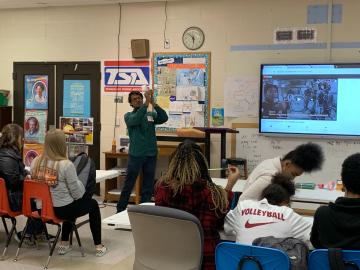
Filter News
Area of Research
News Type
News Topics
- 3-D Printing/Advanced Manufacturing (11)
- Advanced Reactors (4)
- Artificial Intelligence (5)
- Big Data (6)
- Bioenergy (6)
- Biology (2)
- Biomedical (10)
- Biotechnology (1)
- Chemical Sciences (2)
- Clean Water (2)
- Computer Science (19)
- Coronavirus (11)
- Cybersecurity (2)
- Energy Storage (7)
- Environment (8)
- Exascale Computing (2)
- Fusion (9)
- Grid (3)
- High-Performance Computing (1)
- Isotopes (3)
- Machine Learning (2)
- Materials Science (11)
- Mathematics (2)
- Mercury (1)
- Microscopy (3)
- Nanotechnology (3)
- Neutron Science (9)
- Nuclear Energy (17)
- Physics (8)
- Polymers (1)
- Quantum Science (6)
- Security (2)
- Space Exploration (1)
- Summit (7)
- Sustainable Energy (4)
- Transformational Challenge Reactor (3)
- Transportation (5)
Media Contacts

Researchers at the Department of Energy’s Oak Ridge National Laboratory (ORNL) in late February demonstrated a 20-kilowatt bi-directional wireless charging system installed on a UPS medium-duty, plug-in hybrid electric delivery truck.

In the Physics Division of the Department of Energy’s Oak Ridge National Laboratory, James (“Mitch”) Allmond conducts experiments and uses theoretical models to advance our understanding of the structure of atomic nuclei, which are made of various combinations of protons and neutrons (nucleons).

In the race to identify solutions to the COVID-19 pandemic, researchers at the Department of Energy’s Oak Ridge National Laboratory are joining the fight by applying expertise in computational science, advanced manufacturing, data science and neutron science.

Sometimes conducting big science means discovering a species not much larger than a grain of sand.

As a teenager, Kat Royston had a lot of questions. Then an advanced-placement class in physics convinced her all the answers were out there.

Ilias Belharouak is leading ORNL’s research efforts in investigating new materials for solid-state batteries, which can double the charging capacity of lithium-ion batteries, commonly used today for electronic devices such as cell phones.

A software package, 10 years in the making, that can predict the behavior of nuclear reactors’ cores with stunning accuracy has been licensed commercially for the first time.

Hydropower developers must consider many factors when it comes time to license a new project or renew an existing one: How can environmental impacts be mitigated, including to fish populations?

The techniques Theodore Biewer and his colleagues are using to measure whether plasma has the right conditions to create fusion have been around awhile.

“Engineering is about building things to help others.” Before diving into a longer explanation, that’s how Singanallur “Venkat” Venkatakrishnan, an electrical and computer engineer ORNL, described engineering to students at Northwest Middle School.


